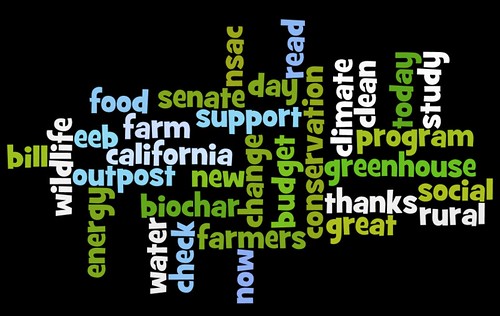As Visiting Scholar at the Packard Foundation, my work plan includes delivering many different peer learning opportunities, coaching, and training with grantees. Yesterday, I had the pleasure of doing a Webinar for grantees of the Agriculture Sub-Program. This blog post summarizes some of the knowledge shared about effective social media strategy, tactics, and practices.
In the many years that I’ve been designing and delivering capacity building and training, I’ve learned being a guide on the side and helping to surface the knowledge and experience in the group produces far richer learning experiences. As a trainer, I strongly believe that learning experiences need to weave content delivery with participant interaction. Also, it is far more effective to have peers share their own case studies and experiential learning with others. I always design to incorporate the voice and experience of the participants.

1. Connecting Learners to the Content and Each Other
Introductions always run the risk of getting a little boring – if you just introduce the presenters, the agenda, and logistics. For this webinar, I incorporate some instant polls so we could get a quick reading on who was on the call. In addition, I wanted to explore TwitChimp, a tool for making Twitter lists, that Robin Good dubbed, “the ultimate Twitter list curation tool.” I created a list of grantee’s Twitter Profiles and shared back the analysis of most tweeted words and hashtags.

What I liked about TwitChimp is that has the ability to add annotations to the link and gather public feedback for additional “tweeps” to add. You can also embed the list into pages which makes it handy for Webinar resource pages. Unfortunately, it is still in beta, so you can only make one list and plans are to make multiple lists a premium feature.
2. Peer Case Studies
The main part of the call featured case studies by peer grantees who shared their strategies for social media integration, measurable objectives, measurement, and social media techniques, particularly use of Twitter.
Daniela Aceves – Communications Manager, Roots of Change, kicked it off with a fantastic case study about a recent campaign. Roots of Change is a fairly small nonprofit, while Daniela’s job is full time, she estimates that only 15% of her time is allocated for social media. She juggles tweeting and Facebook with other communications tasks such as managing the web site and other communications channels. I asked her how she managed her time to be able to get such great results for the organization’s campaigns.
Daniela shared that she works with volunteers and interns and that she does several short bursts during the day to tend to respond or post content Twitter or Facebook. Also, because Daniela has been a great measurement maven, she discovered through analyzing her data that the optimum amount of posting is twice day. She notes, “By focusing on only sharing highly relevant content (and not just our own), we get better results. The important thing is consistency.” She also uses Google Alerts to monitor the conversation and will address important conversations promptly.
Daniela also shared an example of a recent Twitter chat that they have been hosting to raise awareness about food sustainability issues. Through careful tracking of results, she was able to document the return on the investment of her time. I also thrilled to hear how her organization picked up an idea shared at last summer’s grantee convening and adapted grist.org’s ladder of engagement. Everyone agrees, including her boss, that Daniela rocks.

Next up was Hanna Welch, Social Media Producer, from grist.org. As an environmental news site, Hanna’s position is full-time. This allows grist.org to have the capacity to implement a “maven strategy” – that is be on multiple channels where Hanna serves as the community manager. I’ve been lucky to have the opportunity to a great deal about how grist measures its strategy because they were a featured case study in my forthcoming book, “Measuring the Networked Nonprofit” with co-author KD Paine. (Sign up here to receive a notification when it is published)
Hanna shared a wonderful story about the evolution of grist.org’s use of Twitter chats, including #hipsterfarmerbands tag which started as tweets about a story about young farmers and sustainable agricultural practices. Hanna was listening and scanning responses from the network when she noticed that someone had suggested that different, humorous, band names for these hipster farmers. So, they started a fun meme.
Hanna also shared how she spends her day – which is 1/3 strategy, 1/3 research/monitoring, and 1/3 implementation. Her big tip was to connect with peers. Hanna networks with other social media professionals who work for online news sites – using a private Facebook group. She notes, “I can’t emphasize how much time this has saved me to be able to reach out and get instant answers to social media questions. I could not imagine doing social media without connecting to peers.”
Hanna shared an example of how they experiment on other platforms, like Pinterest. It’s a four-step process: 1) read social media trade press 2) discuss with peers 3) present in-house 4) design a measurable, low risk experiment to start.
3. An opportunity to Process and Apply
I always incorporate some sort of reflection. For this design, we will do a second call where participants will have an opportunity to discuss how to apply what they learned.
If you do training, what are your best design tips? If you are applying social media, have you connected with peers either informally or formally to assist with your learning curve? Did it work?
Integrated Social Media for Sustainable Agriculture
Ag Grantees Twitter Webinar
View more presentations from Beth Kanter

Leave a Reply